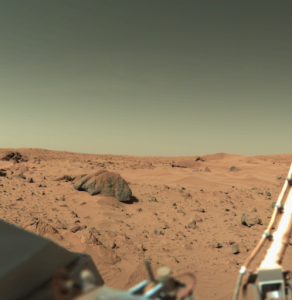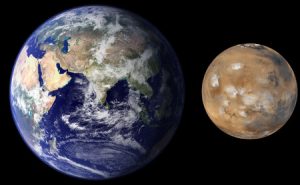Each November 28 is celebrated as “Red Planet Day.” Red Planet Day commemorates the launch of the Spacecraft Mariner 4 on November 28, 1964. Its 228-day mission brought the spacecraft within 6,118 miles of Mars on July 14, 1965, sending us back the first close-up photos of the red planet.
Mars is a very bright planet, and, when it’s in range, you can usually see it without a telescope. Of course, if you have a telescope—or binoculars—you will get a better look. Fortunately, in November the skies are usually clear, and Mars can sometimes be seen in the early morning. With the Internet, you can find a star chart or other guide to show you where the planets should be in the night sky. If you can’t see the stars where you are because of light pollution, ask if your parents can take you out in the countryside where the view is better.
Some Facts about Mars
- Mars was named long ago for the Roman god of war. It was also called Ares by the Greeks for their war god.
- It has two moons, Deimos and Phobos.
- Its “year” around the Sun is 687 days – about 1.88 Earth years.
- It can be very cold or rather warm on Mars. Temperatures range from about -191 to +81 degrees Fahrenheit.
- Mars is red because it is rusty from the iron in the soil. Rusted iron (iron that has been exposed to air) is reddish.
- Its gravity is only roughly 1/3 that of Earth’s.
- Mar’s atmosphere is nothing like the Earth’s. It’s thin and composed mostly of carbon dioxide.
- A man who weighed 100 pounds on Earth would weigh only 38 pounds on Mars because of the difference in gravity.

NASA’s Mars Exploration Program has lots of information on the Red Planet, including videos, still pictures, news about the missions, and more Mars facts. Another good place to look, The Mars Exploration Rover Mission page, gives a lot of details on the robotic vehicles used in exploration.
You can also find good reading on our nearest neighboring planet in the library. Click on any title to begin the reservation process.
True Tales
Birthday on Mars! by Sara Schonfeld
Mars is one of our closest neighbors, and a NASA robot named Curiosity is in charge of exploring the surface. Take a journey across a new planet along with Curiosity.
Cars on Mars by Alexandra Siy
Readers can follow the course of NASA’s Mars Exploration Rover (MER) mission as twin rovers, Spirit and Opportunity, explore the Red Planet. Learn how scientists determined that there was once water on Mars and how the Earthbound NASA team resolved problems with the rovers from afar in order to prolong the mission, which continues today. The author provides insight into scientists’ quest to discover whether life may have or still might exist on Mars. Back matter includes a glossary, source notes, and resources.
Curiosity by Marcus Motum
Maybe you remember when a little robotic spacecraft landed on a far-off planet. On August 6, 2012, the rover Curiosity touched down on the rocky surface of Mars and now she's ready to guide you through her journey firsthand. From idea to creation and beyond, this fact-filled, stylish book introduces readers to Curiosity and her mission: to discover more about the red planet and search for evidence of life.
Destination: Mars by Seymour Simon
Explore the wonders of Mars, the Red Planet, with science writer Seymour Simon in this updated edition filled with full-color photographs and spacecraft images
Far-out Guide to Mars by Mary Kay Carson
Rock-hunting rovers -- Mars at a glance -- Fast facts about Mars -- Mars timeline of exploration and discovery -- Digging for Martian ice -- What's next for Mars?
A Kid's Guide to Mars / Jet 2 (streaming video from Kanopy)
Celery and Carrot need to update their guidebook about Mars, and the kids join them on a trip to see how much things have changed on Mars in the last four billion years.
Welcome to Mars by Buzz Aldrin
Apollo 11 astronaut invites young people to evaluate Mars as a potential planet for human colonization and describes what Mars residents might experience while traveling to and living on the Red Planet.
Welcome to Mars a video from National Geographic
Mission Control and its two robotic explorers face a daunting task--find proof that liquid water, the essential ingredient of life, once existed on Mars. From the white-knuckle landings of the Mars rovers Spirit and Opportunity, through months of frustrating setbacks and elating discoveries, Welcome to Mars captures the gripping drama and the breathtaking images of the most significant mission events which allow NASA to announce solid proof that Mars was once awash in water.
Adventure Stories
Before we knew what Mars was really like, many writers imagined all sorts of monsters lived there, ready to invade the Earth. More recent writers take what we know now and turn it into stories set just a little in the future.
The Countdown Conspiracy by Kati Slivensky
Six kids from around the world have been chosen for the first-ever mission to Mars, and Miranda Regent is one of them.
Mars by Hena Khan and David Borgenicht, with Robert Zubrin
As a member of a young crew of astronauts on Mars, the reader is faced with real dangers and must make decisions that will determine the success of the mission.
Mousetronaut Goes to Mars by Mark E. Kelly
A mouse stowaway on NASA's first human mission to Mars becomes a hero when one of the landing craft's engines fails. Includes facts about Mars. This picture book was written by a retired astronaut.
There's Nothing to Do on Mars written and illustrated by Chris Gall
When Davey Martin's family moves to Mars, he discovers that there's nothing to do--at least until he and his robot dog Polaris learn to seize the spirit of adventure. It's not until they've zipped around the planet on his flying scooter--climbing Martian "trees," digging up "fossils," dancing in Martian rain dances--that they discover a treasure that finally piques Davey's interest--a source of water on the red planet!
You Are the First Kid on Mars by Patrick O'Brien
In the spirit of books that once imagined colonies on the moon, Patrick O'Brien has created a unique look at your first trip to Mars. Using the most up-to-date designs and theories of what it will take to establish a base on Mars, you are off on an incredible journey, over 35 million miles to the red planet. Filled with details, and vividly brought to life, this is an adventure that you are never going to forget.
The War of the Worlds by H.G. Wells; retold by Davis Worth Miller and Katherine McLean Brevard
Graphic novel adaptation of H.G. Wells' classic science fiction tale in which, as life on Mars becomes impossible, Martians and their terrifying machines invade the Earth.



